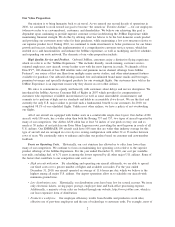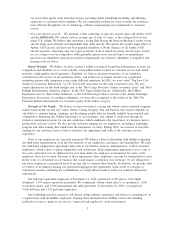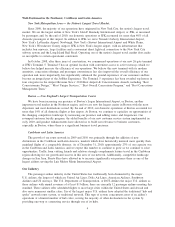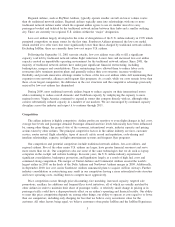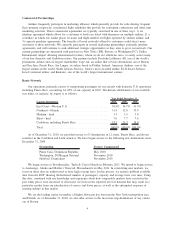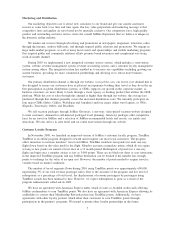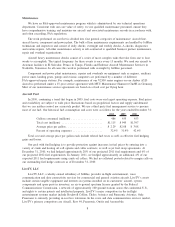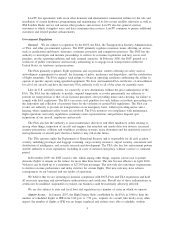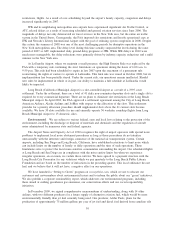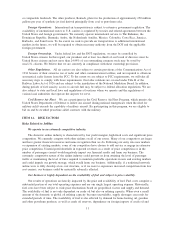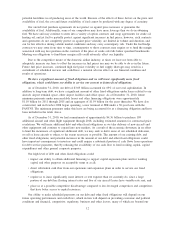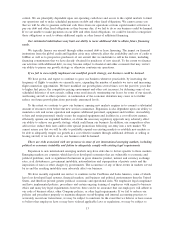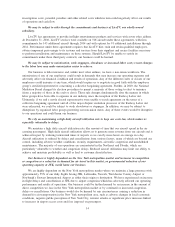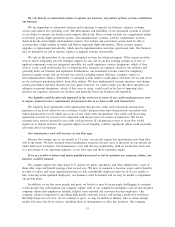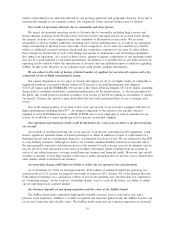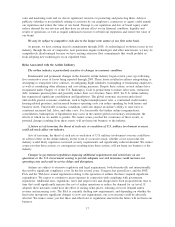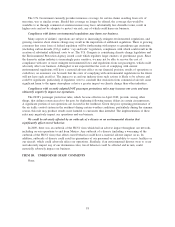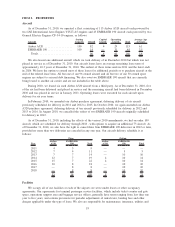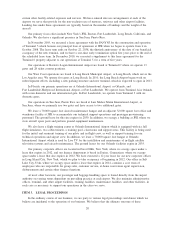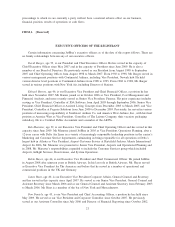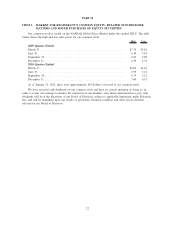JetBlue Airlines 2010 Annual Report Download - page 21
Download and view the complete annual report
Please find page 21 of the 2010 JetBlue Airlines annual report below. You can navigate through the pages in the report by either clicking on the pages listed below, or by using the keyword search tool below to find specific information within the annual report.potential hostilities in oil producing areas of the world. Because of the effects of these factors on the price and
availability of fuel, the cost and future availability of fuel cannot be predicted with any degree of certainty.
Our aircraft fuel purchase agreements do not protect us against price increases or guarantee the
availability of fuel. Additionally, some of our competitors may have more leverage than we do in obtaining
fuel. We have and may continue to enter into a variety of option contracts and swap agreements for crude oil,
heating oil, and jet fuel to partially protect against significant increases in fuel prices; however, such contracts
and agreements do not completely protect us against price volatility, are limited in volume and duration, and
can be less effective during volatile market conditions and may carry counterparty risk. Under the fuel hedge
contracts we may enter from time to time, counterparties to those contracts may require us to fund the margin
associated with any loss position on the contracts if the price of crude oils falls below specified benchmarks.
Meeting our obligations to fund these margin calls could adversely affect our liquidity.
Due to the competitive nature of the domestic airline industry, at times we have not been able to
adequately increase our fares to offset the increases in fuel prices nor may we be able to do so in the future.
Future fuel price increases, continued high fuel price volatility or fuel supply shortages may result in a
curtailment of scheduled services and could have a material adverse effect on our financial condition and
results of operations.
We have a significant amount of fixed obligations and we will incur significantly more fixed
obligations, which could harm our ability to service our current or future fixed obligations.
As of December 31, 2010, our debt of $3.03 billion accounted for 65% of our total capitalization. In
addition to long-term debt, we have a significant amount of other fixed obligations under leases related to our
aircraft, airport terminal space, other airport facilities and office space. As of December 31, 2010, future
minimum payments under noncancelable leases and other financing obligations were approximately
$1.10 billion for 2011 through 2015 and an aggregate of $1.59 billion for the years thereafter. We have also
constructed, and in October 2008 began operating, a new terminal at JFK under a 30-year lease with the
PANYNJ. The minimum payments under this lease are being accounted for as a financing obligation and have
been included in the totals above.
As of December 31, 2010, we had commitments of approximately $4.36 billion to purchase 109
additional aircraft and other flight equipment through 2018, including estimated amounts for contractual price
escalations. We will incur additional debt and other fixed obligations as we take delivery of new aircraft and
other equipment and continue to expand into new markets. As a result of the economic downturn, in an effort
to limit the incurrence of significant additional debt, we may seek to defer some of our scheduled deliveries,
or sell or lease aircraft to others, to the extent necessary or possible. The amount of our existing debt, and
other fixed obligations, and potential increases in the amount of our debt and other fixed obligations could
have important consequences to investors and could require a substantial portion of cash flows from operations
for debt service payments, thereby reducing the availability of our cash flow to fund working capital, capital
expenditures and other general corporate purposes.
Our high level of debt and other fixed obligations could:
• impact our ability to obtain additional financing to support capital expansion plans and for working
capital and other purposes on acceptable terms or at all;
• divert substantial cash flow from our operations and expansion plans in order to service our fixed
obligations;
• require us to incur significantly more interest or rent expense than we currently do, since a large
portion of our debt has floating interest rates and five of our aircraft leases have variable-rate rent; and
• place us at a possible competitive disadvantage compared to less leveraged competitors and competitors
that have better access to capital resources.
Our ability to make scheduled payments on our debt and other fixed obligations will depend on our
future operating performance and cash flows, which in turn will depend on prevailing economic and political
conditions and financial, competitive, regulatory, business and other factors, many of which are beyond our
12


